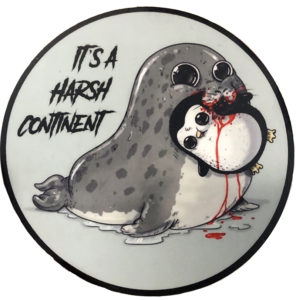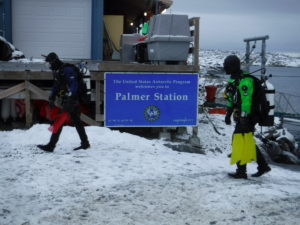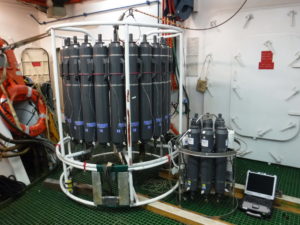World Penguin Day

Or as my colleague Wade calls it, “Take a Leopard Seal to Lunch Day”. (The image is of a sticker that I bought at Palmer Station – oceanographers can have a warped sense of humor.) But, since we are in the Antarctic, I should say something about penguins. They are amusing to watch. Clumsy on land but amazing acrobats in the water. The belly-slide is a more effective way for them to travel on snow than walking. They are extremely curious, to the point of being pests. On my first trip down here, the ship was in ice the entire time because the lead research group was studying sea ice. Every day they’d lay out a measuring line for their ice coring transect, pinning it down with small metal stakes. And then the penguins would show up (the Adelies) to inspect the job and pull out a bunch of the stakes. They are the squirrels of the Antarctic. That’s about all I know regarding penguins – you can certainly find out more through the internet (or a book), as well as find some really cute pictures and funny videos.
It’s also my brother’s birthday today, so before I go any further I’d like to say
HAPPY BIRTHDAY BRYAN!!
(Sorry, I forgot to send a card before I left.)
A few days have gone by since the last post. It all started out well – on Monday the divers did their checkout dives at Palmer Station. The picture below is of our chief scientist Chuck Amsler (all black dive suit – there is an island named in his honor near the station) and Aaron Galloway (neon green dive suit) exiting the water. We left the dock just before dinner and headed to the first site where we would collect water and the divers would collect macroalgae for their project. Finally we would begin working on our project! Unfortunately, there was a major glitch – the CTD failed on its first cast Tuesday morning. It wasn’t repairable and there isn’t a spare onboard this ship.

The CTD is an instrument package that attaches to a large frame (called a rosette – it’s round) that holds large bottles (called Niskin bottles) that can be triggered to shut from the ship. CTD stands for conductivity/temperature/depth, which are the primary water conditions that the instrument it measures. We added a fluorometer to the group so that we could measure fluorescence in the water – which is used as a proxy for microalgal abundance. Using this information gathered by the instrument on its way down through the water column, we decide at what depth we want to collect water samples, which is done as the instrument comes back to the surface. All of our experiments require seawater, and while we could get surface water with a bucket, we are also interested in deeper water – the deep fluorescence maximum in particular. Without a functional CTD, it was looking pretty bleak for our project.
We headed on to the next dive site, ending up in lousy weather that kept the divers out of the water. Wednesday was spent brainstorming different ideas, and there were many, but ultimately it was decided that we would head back to Palmer Station and borrow their smaller instrument. And that’s where we are now (Thursday morning) – we’ve picked up the CTD and it is being attached to the winch wire for a test deployment. In the picture below you can see the two rosettes side-by-side. On the left is the original CTD (which decided it didn’t want to cooperate for this cruise) and on the right is the borrowed one. There is a definitely a difference in the amount of water that we can collect on each cast, and we’ll likely need to do multiple casts to get what we need, but it’s a much better alternative than a bucket (we have 2 of those – just in case).

And, I’d like to be serious for a moment. At sea we always seem to be modifying or adapting something, but when major issues like this occur (and they do), it requires a big team effort to make it right. I’m not going to try to name the folks involved because I’ll inevitably forget to include someone – but if you were a part of helping to solve this problem, please know that we are very, very grateful.